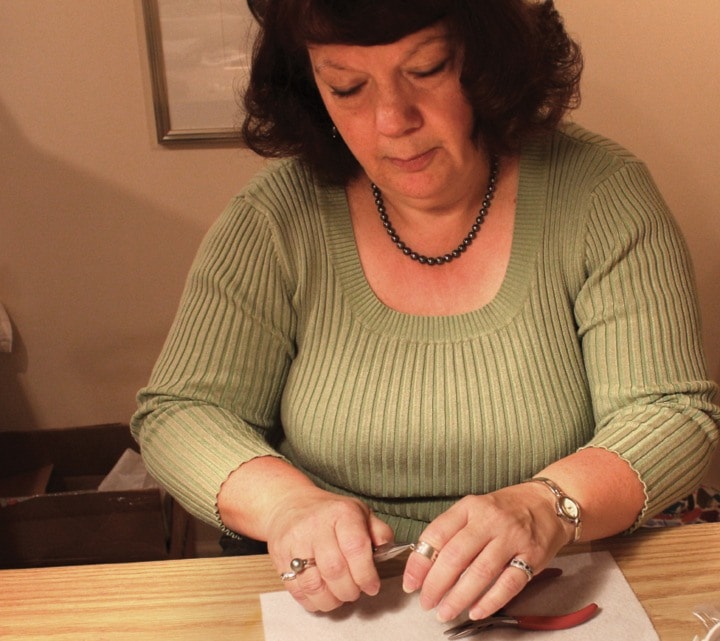Karola Schabernak has worked since she was 16 in the forest industry. She grew up in Youbou and says that though she has tried other forms of employment over the years, such as working in retail management when she lived in Vancouver, she could not make as much money as she could planting trees.
Schabernak has also worked in the forest industry as a forestry technician, industry newspaper editor, and first aid attendant, but ever since she was a child, she has always been interested in art.
After joining the Kaatza Art Group, Schabernak decided to renovate her basement and open RainFlower Studio, where she has on display the many forms of art she both works and experiments with.
“The art I’ve been doing on and off since 1974,” said Schabernak. “[Though] not selling it up until about eight years ago.”
On the walls of her studio hang examples of Japanese Sumi-e, Chinese brush painting, traditional landscapes and florals, logging cartoons from her days editing a logging industry newspaper, and much more.
Over the last few years Schabernak has been delving into jewelry as well. She hand knots pearls using silk thread.
“The reason for knotting them is that it protects one pearl from the other,” said Schabernak. This allows the strands to drape in a fashion that it does not using jewelry wire.
Schabernak has also been learning how to create chain mail jewelry.
“What I do is hand coil sterling silver wire on a mandril and then I cut it with a coil cutter [an electric saw]. Then, I take the little rings and I have these jewelry pliers.”
She then takes the rings and links them together. It’s a complicated process that involves math calculations in order to get the pattern right or the chain will not drape properly.
Schabernak is well read and very interested in history, and this shows in much of her art. Though she says she is a Christian, she states that she has read so much about the many different religions out there in the world that she has come to her own conclusion about a common thread between them all.
“All the good ones say the same thing, and I live by those tenants myself, but at the same time I have my own ideas about stuff.”
Schabernak was raised a Catholic until the age of four, but the priest at the church her family attended didn’t like the fact that her parents came from Germany and Austria, and so they no longer attended. This experience taught Schabernak a lesson about the world.
“So I thought, well there you go, that’s how contempt is bred, you know, by people not wanting me in that church, for example.”
Years later she painted a tree of life that she had hanging behind her desk in one of the offices she worked in. The image triggered a conversation between a gentleman and herself. The gentleman wanted to know if Schabernak knew the difference between a tree of life and a tree of knowledge, and he had many other questions.
“This triggered a three hour conversation,” she explained. “And I know I learned something, but I would like to think that he learned something too.”
She used this story as an example to illustrate how people can take their own meanings from art, but also how art can trigger conversations and learning circumstances between people.
She also feels that even though each of her pieces has an emotional value to her, it has to be shared with the world.
“For people to appreciate and view,” explains Schabernak. “When I wasn’t very good at it, I kept them because I wasn’t very good at it. I didn’t want to send something out there that I wasn’t pleased with. Although, if someone insisted they wanted it, despite the fact that I wasn’t very pleased with it, I would sell it to them because they saw something in it that I didn’t see. I’m perfectly willing to send them out into the world because that’s where they belong.”
She takes this a step further though, too. Her art is not just passive in her eyes, it has a function in the world.
“I try to imbue everything I do with positive vibration as well, and to send that positive vibration out there.”
Generally, Schabernak says that when she begins creating a piece an idea will germinate within her imagination, and that one idea will feed off of subsequent ideas as the piece is being worked.
“Then what happens is, you’re directing the piece and the piece is directing you,” said Schabernak. This symbiotic relationship helps to bring about the naming of her pieces, says Schabernak.
“People often ask me, how did you get the names for your paintings? The thing about it is, by the time the painting is finished, it has told me its name.”
Schabernak’s art is plentiful and varied in its forms, and it is well worth going to her studio to view.
She is open to visitors, but only by appointment as she also has a day job at the Community Forest Co-op.
You can reach Schabernak by phone at 250-749-3650.
